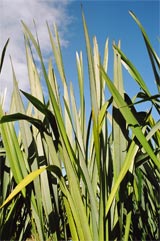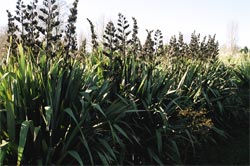 This page features extracts from recorded interviews with Christine Heremaia and Ranui Ngarimu speaking about Janet Stewart reserve, its pā harakeke, ‘te korari’ and weaving.
This page features extracts from recorded interviews with Christine Heremaia and Ranui Ngarimu speaking about Janet Stewart reserve, its pā harakeke, ‘te korari’ and weaving.
Ranui Ngarimu (Kāti Māmoe / Ngāi Tahu / Ngāti Mutunga) has had an interest in weaving since she was a child. She is an expert weaver and is involved in the restoration of kākahu for a number of prominent Ngāi Tahu whānau. When interviewed in 2005 she was the Chair of the national weavers collective Te Rōpū Raranga Whatu O Aotearoa.
Christine Heremaia worked for the Greenspace Unit at Christchurch City Council where she was the Styx Project Area leader. During her time with the Council she was extensively involved in waterways and wetlands management including the establishment of the Janet Stewart Reserve. She passed away in 2014.
Listen to Ranui Ngarimu’s Weaving Journey [3.7MB MP3]
Janet Stewart Reserve
Cross the Styx River bridge on Marshlands Road and you catch a fleeting glimpse of a mass of green blades — a lush plantation of harakeke. In early winter, the blackened kōrari flower heads appear etched against the sky. Pūrākaunui (the Styx River) meanders through this 1.9 hectare roadside oasis which provides a tranquil repose for visitors and native wildlife alike.
Christine speaks about the Styx River project [5MB MP3]
The Janet Stewart Reserve was officially named in 1996. Since that time, the flat, willow bordered paddock has been transformed into a thriving habitat for bush and wetland birds. The Reserve is on land generously bequeathed to Christchurch City Council by Edmond Stewart on condition that it be developed as a public reserve and named after his mother Janet. The restoration of natural landscape features in Janet Stewart Reserve is part of the wider Styx River project which involves the ongoing development of a Styx Mill Conservation Reserve.
The final form of the Janet Stewart Reserve evolved to include the creation of a lake, jetty, walkways and car park. Native plantings were used to provide a habitat feature for the reserve. The boxed waterway was released to form a large pond that was surrounded by riparian planting.
 Te Kōrari – a Pā Harakeke
Te Kōrari – a Pā Harakeke
Janet Stewart Reserve incorporates an extensive Pā Harakeke — a planted area of special flaxes suitable for traditional Māori weaving. It is named Te Kōrari and is a taonga (treasure) for the Christchurch weaving community.
The council worked closely with a group of local weavers and Landcare Research in the planting of this pā harakeke. Te Kōrari is one of a number of pā harakeke plantings established on reserves around Christchurch for weaving purposes. The harakeke at Janet Stewart originates from plants in the Foxton flax milling area. They were initially grown in Christchurch as part of a research project and when no longer needed, were transferred for planting at Janet Stewart Reserve in 1998.
Ranui speaks about the varieties & uses of harakeke & wharariki [2.9MB MP3]
Several varieties of harakeke (phormium tenax) and wharariki (phormium cookianum) grow at the reserve. Harakeke has a strong fibre and is traditionally used for making whāriki (mats), kete, pāraerae (sandals) and the fibre (whītau or muka) is extracted for kākahu (cloak) making. Some of the readily identifiable varieties of harakeke growing in Te Kōrari at the Janet Stewart Reserve are kohunga, ruapani, taeore and makaweroa.
Wharariki has softer more pliable leaves that are prized for use in smaller more delicate work.
Whakataukī / Proverb
Ka nui te Harakeke, ka ua te ua.
When the harakeke plants are plentiful, it is a sign of much rain.
Ranui speaks about the management of a pā harakeke [5.7MB]
Tikanga (custom)
There are many cultural and spiritual elements associated with harakeke, its harvesting and its uses. It is very important to understand and recognise the indigenous knowledge associated with the plant. Learn more about the tikanga of harakeke on our harakeke page.
Raranga (weaving)
In early times the art of weaving was essential to Māori. The whāriki (mat) for covering the floors of the whare, the kete or kono for carrying kai, the hīnaki (trap) for snaring eels, the piupiu and the korowai to clothe and adorn the body, and the tukutuku - the decorative panels on the walls in a meeting house were all woven using harakeke. This marvellous and various plant grows in abundance here at this Pā harakeke, Te Kōrari in the Janet Stewart Reserve.
Weaving is acknowledged as having its own life force, and is accorded a level of respect depending on the mana of the weaver and the qualities of the weaving process.
Aitia te wāhine i roto i te Pā Harakeke
bond with women who work with Harakeke
(for she will prosper)
Karakia / Whakataukī
Ranui speaks about karakia [1.3MB MP3]
Hutia te rito
o te harakeke
Kei whea, te kāmako e kō?
Kī mai ki ahau
He aha te mea nui
o tēnei ao
Māku e kī atu
He tangata, he tangata, he tangata.When the heart is torn
from the flax bush
where will the Bell bird sing?
You ask me
what is the greatest thing
on Earth
My reply is
it is people people people
Libraries’ Waiata Group sing the Karakia ‘Hutia Te Rito’ [803KB MP3]
This whakataukī defines the human person as the most important element in the universe. It is quoted often in speeches and whaikōrero to emphasize the mana and tapu of humankind. It also acknowledges human fragility, interdependence and dependence on other parts of the creation: if you pluck out the heart of the flax bush where the bellbird would sing.
Acknowledgements
The Janet Stewart Reserve development was achieved in partnership with the Stewart family, Christchurch City Council, Shirley/Papanui Community Board, Burwood/Pegasus Community Board, Waiora Trust, Landcare Research, Local Weavers group — Te Kōrari, the local Scout Group, The Guardians of the Styx and members of the wider local community.
A permit is required to harvest flax from this area. Please contact Christchurch City Council to obtain a permit or more information about the pā harakeke.
Sources
- Ngairimu, Ranui. Interview by Helen Brown. Te Wai Pounamu House, Christchurch, DAT recording, 14 June 2005.
- Heremaia, Christine. Recording by Helen Brown. Christchurch City Council Building, DAT recording, 9 June 2005.
Related pages
- Harakeke
- Janet Stewart Reserve page from Pūawaitanga o te Ringa — Fruits of our busy hands, the name given to the series of tukutuku panels that were specially woven as a community project in 2001. This page includes more specific information about the Janet Stewart Reserve project including a planting plan.
- Māori weaving and fibre arts
Links
- Landcare Research looks at pā harakeke, a planting of selected varieties of harakeke
- Janet Stewart Reserve - Christchurch City Council
